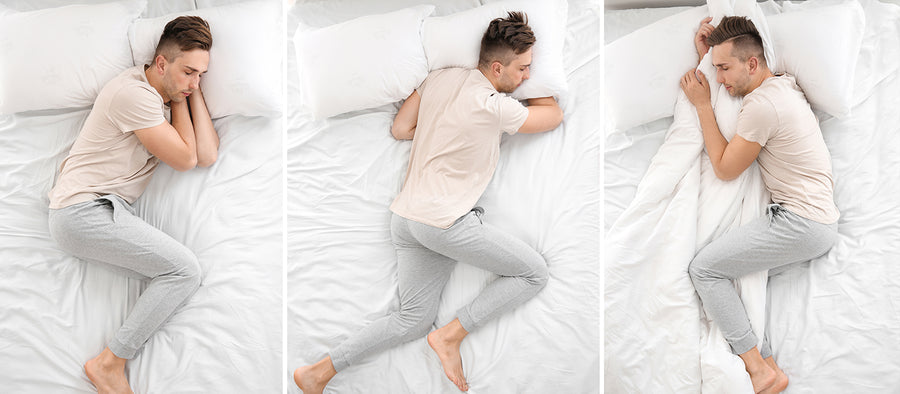You have no items in your shopping cart.
The Top Sleeping Positions for Alleviating Lower Back Pain
If you're one of the many people who suffer from lower back pain, you know how difficult it can be to get a good night's sleep. The pain can make it challenging to find a comfortable position, and even if you do manage to drift off, you may wake up feeling stiff and sore. However, there are several sleeping positions that can help to alleviate lower back pain and promote a restful night's sleep. In this article, we'll explore the top sleeping positions for lower back pain, as well as some other tips for getting a good night's rest.
Sleeping on your back
Sleeping on your back is generally considered to be the best position for people with lower back pain. This is because it allows your spine to maintain a neutral position, which helps to alleviate pressure on the lower back. When sleeping on your back, it's important to use a pillow to support your neck and a small pillow or rolled-up towel to support the natural curve of your lower back. If you find that sleeping on your back causes snoring or sleep apnea, try using a pillow to elevate your head slightly.
Sleeping on your side
Sleeping on your side can also be an effective position for alleviating lower back pain. When sleeping on your side, place a pillow between your knees to keep your hips in alignment and reduce pressure on your lower back. It's important to make sure that the pillow is firm enough to keep your hips in place but not so thick that it puts additional pressure on your lower back.
Sleeping in the fetal position
Sleeping in the fetal position is another option for people with lower back pain. This position involves sleeping on your side with your knees pulled up to your chest. While this can help to alleviate lower back pain, it can also cause your spine to round, which can exacerbate the problem. If you do choose to sleep in the fetal position, make sure to use a pillow to support your neck and keep your spine as straight as possible.
Sleeping on your stomach
Sleeping on your stomach is generally not recommended for people with lower back pain. This is because it can cause your spine to arch, which puts pressure on the lower back. If you do prefer to sleep on your stomach, try using a pillow to prop up your hips and reduce pressure on your lower back. You should also use a thin pillow or no pillow at all for your head to keep your neck in a neutral position.
Sleeping on an adjustable bed
If you suffer from chronic lower back pain, an adjustable bed may be a good investment. These beds allow you to adjust the angle of the bed to find a comfortable position that supports your lower back. You can also use an adjustable bed to elevate your head and feet, which can help to reduce pressure on your lower back.
Other tips for getting a good night's sleep with lower back pain
In addition to adjusting your sleeping position, there are several other tips you can follow to promote a restful night's sleep:
Stay active
Exercise is an important component of maintaining a healthy back. Regular exercise can help to improve flexibility and strength, which can reduce the risk of lower back pain.
Reduce stress
Stress can exacerbate lower back pain. Make sure to take time to relax and reduce stress in your daily life. This can include practicing meditation, yoga, or other relaxation techniques.
Stay hydrated
Staying hydrated is important for maintaining a healthy back. This is because dehydration can cause the spinal discs to lose fluid, which can lead to lower back pain. Make sure to drink plenty of water throughout the day.
Maintain a healthy weight
Carrying excess weight can put additional pressure on your lower back. Maintaining a healthy weight through regular exercise and a healthy diet can help to reduce the risk of lower back pain.
Seek medical advice
If you suffer from chronic lower back pain, it's important to seek medical advice. A doctor or physical therapist can help you to develop a treatment plan that includes exercise, pain management techniques, and other interventions that can help to reduce your symptoms.
Invest in a supportive mattress
A supportive mattress is key to reducing lower back pain. Look for a mattress that is firm enough to provide support but still conforms to your body.
Use supportive pillows
In addition to using a pillow to support your neck and lower back, consider using a body pillow to support your entire body. This can help to reduce pressure on your lower back and promote a more restful sleep.
Conclusion
Lower back pain can be a frustrating and debilitating condition that can make it difficult to get a good night's sleep. However, by adjusting your sleeping position and following other tips for promoting a restful sleep, you can reduce your symptoms and wake up feeling refreshed and rejuvenated. If you suffer from chronic lower back pain, it's important to seek medical advice to develop a treatment plan that works for you. With the right care and attention, you can reduce your pain and improve your quality of life.
 English
English







